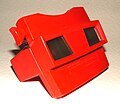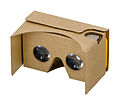History of video games/VR
Early developments
[edit | edit source]While not the primary point of the story, a simulated reality is featured prominently in the Allegory of the Cave by the ancient Greek philosopher Plato[1][2][3] around 360 B.C.E.[4] While not VR as it is known today, the story not only shows the existence of simulated realities as a concept long before the invention of multimedia technology, it also shows an uncanny understanding of some of the same ethical questions people would ask about addiction to virtual worlds thousands of years later.[5][6] A similar concept also exists in Zhuangzi's ancient Daoist text the Butterfly Dream a third century B.C.E. story written in ancient China, though the method of simulation and lesson of the story are rather different.[7]
Simple stereoscopic displays have attempted to to offer immersive experiences since 1838 with the invention of the Stereoscope in Britain.[8][9] Rival Scottish physicist Sir David Brewster specialized in optics, having previously invented such things as the Kaleidoscope, and crafted a more refined and portable stereoscope.[10][11]
During the 1950's and 1960's a number of attempts were made to create more immersive experiences.[12]
Prototype Technology of the 1980's and 1990's
[edit | edit source]During the Cold War there was a massive amount of Research and Development ongoing by both government and commercial agencies, which had a side effect of trickling down to consumers later, namely in Virtual Reality, and general advances in computing. During this time, a number of marketing attempts to promote the technology would be made.[13] Though this technology would not see common consumer use in the 1980's and 1990's, it would form the basis for common gaming technologies decades later.
By 1992 there was a VR Golf center in New York City and a VR Mech Arcade in Chicago.[14]
Rebirth of Virtual Reality
[edit | edit source]The early 2010's saw a renewed interest in VR with crowdfunding platforms providing capital to spur development.[15][16] The mid 2010's saw large corporations begin to push into the field with their own entries in VR, AR, and MR.[17][18][19]
VR technology became a popular theme in science fiction around this time, and VR games were frequently used as a plot device in non-gaming media as a way of taking characters to another world with a more scientifically plausible technology. Popular fictional stories of the 2010's such as Ernest Cline's 2011 novel Ready Player One and Steven Spielberg's 2018 film of the same name[20] and Sword Art Online[21] prominently feature VR in their stories. Such fictional works in turn influenced VR content creators during this time, who strove to bring fiction to virtual reality.[22][23]
Around 2016 and 2017 media outlets began frequently expressing concern about the safety of VR.[24][25]
By 2021 around 1/5 of Facebook employees were doing work related to their VR platforms.[26][27]
High End VR
[edit | edit source]Oculus Rift
[edit | edit source]Low End VR
[edit | edit source]Interest in VR sparked interest in lowering the barrier of entry to VR experiences.
Read More
[edit | edit source]References
[edit | edit source]- ↑ "Modern Spin on Plato's Cave Explores the Limits of 3D Reality" (in en). www.vice.com. https://www.vice.com/en/article/78e3xa/platos-cave-allegory-video-with-3d-quantum-mechanics.
- ↑ Kane, Pat. "Escape to the future with virtual reality". New Scientist. https://www.newscientist.com/article/2138305-escape-to-the-future-with-virtual-reality/.
- ↑ "The Promise and Disappointment of Virtual Reality". Literary Hub. 28 November 2017. https://lithub.com/the-promise-and-disappointment-of-virtual-reality/.
- ↑ "Queensborough Community College". www.qcc.cuny.edu. Retrieved 18 December 2020.
- ↑ Johansson, Anna (17 April 2018). "9 ethical problems with VR we still have to solve" (in en-us). The Next Web. https://thenextweb.com/contributors/2018/04/18/9-ethical-problems-vr-still-solve/.
- ↑ "Allegory of the Cave Story" (in english). Destructoid. https://www.destructoid.com/stories/allegory-of-the-cave-story-193555.phtml.
- ↑ "Zhuangzi's Butterfly Dream Decentered". Retrieved 18 December 2020.
- ↑ "History of Virtual Reality". The Franklin Institute. 21 October 2016. Retrieved 27 November 2020.
- ↑ Thompson, Clive. "Stereographs Were the Original Virtual Reality". Smithsonian Magazine. Retrieved 27 November 2020.
- ↑ "Molecular Expressions: Science, Optics and You - Timeline - Sir David Brewster". micro.magnet.fsu.edu. Retrieved 27 November 2020.
- ↑ "180 years of 3D". Retrieved 27 November 2020.
- ↑ "History of Virtual Reality". The Franklin Institute. 21 October 2016. Retrieved 18 December 2020.
- ↑ "The Wacky World of VR in the 80s and 90s". PCMAG. Retrieved 25 November 2020.
- ↑ "Almost Reality -- A Look at Virtual Reality". www.gamezero.com. Retrieved 21 November 2020.
- ↑ "The Rise and Fall and Rise of Virtual Reality". The Verge. Retrieved 28 November 2020.
- ↑ "Oculus responds to Kickstarter criticism with free headsets". the Guardian. 6 January 2016. Retrieved 28 November 2020.
- ↑ Manjoo, Farhad (22 January 2015). "Microsoft HoloLens: A Sensational Vision of the PC's Future (Published 2015)". The New York Times. Retrieved 28 November 2020.
- ↑ Miller, Claire Cain (8 April 2014). "At Google, Bid to Put Its Glasses to Work (Published 2014)". The New York Times. Retrieved 28 November 2020.
- ↑ "Facebook's $2 Billion Acquisition Of Oculus Closes, Now Official". TechCrunch. Retrieved 28 November 2020.
- ↑ Roettgers, Janko (29 March 2018). "How ‘Ready Player One’ Compares to Today’s VR Technology". Variety. https://variety.com/2018/digital/news/ready-player-one-vr-tech-1202739419/.
- ↑ "Manga Books - Best Sellers - Books - April 27, 2014 - The New York Times". The New York Times. https://www.nytimes.com/books/best-sellers/2014/04/27/manga/.
- ↑ "Ernest Cline talks Ready Player One, Spielberg, and the future of VR" (in en). The Independent. 30 March 2018. https://www.independent.co.uk/arts-entertainment/films/features/ready-player-one-ernest-cline-interview-steven-spielberg-virtual-reality-vr-a8277996.html.
- ↑ Lang, Ben (4 June 2017). "Taking After 'Sword Art Online', Oculus Founder Wants to Make a VR Game With Serious Consequences". Road to VR. https://www.roadtovr.com/oculus-founder-wants-to-make-vr-game-with-serious-consequences-permadeath-sword-art-online/.
- ↑ Stein, Scott. "The real dangers of virtual reality" (in en). CNET. https://www.cnet.com/news/the-dangers-of-virtual-reality/.
- ↑ CNN, By Sandee LaMotte (13 December 2017). "The very real health dangers of virtual reality" (in en). CNN. https://www.cnn.com/2017/12/13/health/virtual-reality-vr-dangers-safety.
- ↑ "Facebook Now Has 10,000 People Working on VR and AR Devices". MUO. 12 March 2021. https://www.makeuseof.com/facebook-ar-vr-development/.
- ↑ Byford, Sam (12 March 2021). "Almost a fifth of Facebook employees are now working on VR and AR: report" (in en). The Verge. https://www.theverge.com/2021/3/12/22326875/facebook-reality-labs-ar-vr-headcount-report.





























